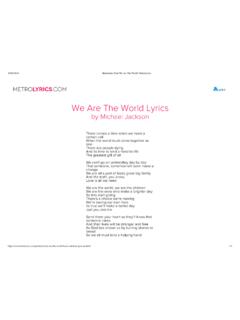Transcription of Exposure to Violent Media: The Effects of Songs With ...
1 Exposure to Violent Media: The Effects of Songs With Violent lyrics onAggressive Thoughts and FeelingsCraig A. Anderson and Nicholas L. CarnageyIowa State UniversityJanie EubanksTexas Department of Human ServicesFive experiments examined Effects of Songs with Violent lyrics on aggressive thoughts and hostilefeelings. Experiments 1, 3, 4 and 5 demonstrated that college students who heard a Violent song felt morehostile than those who heard a similar but nonviolent song. Experiments 2 5 demonstrated a similarincrease in aggressive thoughts. These Effects replicated across Songs and song types ( , rock,humorous, nonhumorous). Experiments 3 5 also demonstrated that trait hostility was positively relatedto state hostility but did not moderate the song lyric Effects . Discussion centers on the potential role oflyric content on aggression in short-term settings, relation to catharsis and other media violence domains,development of aggressive personality, differences between long-term and short-term Effects , andpossible mitigating told me once that there s a right and wrong.
2 Punishment wascure for those who dare cross the line. But it must not be true forjerk-offs just like you. And maybe it s just bullshit. I should play godand shoot you myself. Tool, Jerk-Off (1992)As evidenced by the creation of the Parents Music ResourceCenter and the policy of labeling music products containing vio-lent lyrics , many people are concerned with potential deleteriouseffects of listening to Songs with Violent lyrics . An accumulatingbody of scientific research spanning 4 decades supports the hy-pothesis that Exposure to Violent media is causally related tosubsequent expression of aggression in both short- and long-termtime frames ( , Anderson & Bushman, 2002a; Berkowitz, 1993;Bushman & Anderson, 2001). The vast majority of this researchhas focused on Violent television and movies (Huesmann & Miller,1994). Recently, a small but relatively consistent research litera-ture has shown that short-term Exposure to Violent video gamescauses increases in aggression and aggression-related variables(Anderson & Bushman, 2001).
3 Nonetheless, there remains among the general population andmany practitioners a very strong belief in the age-oldcatharsishypothesis the belief that experiencing and expressing aggressiveemotions and thoughts will decrease subsequent aggressivethoughts, feelings, and emotions (Bushman, 2002; Bushman,Baumeister, & Stack, 1999). This ancient Greek idea, later popu-larized by Breuer and Freud (1893 1895/1955) and now usuallylabeledventing, states that aggressive impulses can be reduced bywatching, reading, or singing about anger and aggression as wellas by behaving in symbolically aggressive ways. Though theaggression catharsis hypothesis has been thoroughly explored anddebunked in several entertainment media domains, there has beenrelatively little work on the Effects of Songs with Violent lyrics onaggression-related variables such as aggressive thoughts DifferencesThere are numerous differences between watching Violent tele-vision, playing Violent video games, and listening to popularmusic.
4 One is the lack of a video component to audio-only is that aggressive lyrical content of popular music is oftendiscernible only to the most attentive of listeners, whereas video-based media (including music videos) make their Violent contentabundantly and graphically clear. Some rock music Songs havesuch garbled lyrics that they have given rise to debates about whatthe lyrics are ( , Louie, Louie ; Inna-Godda-Da-Vida ; seeMarsh, 1993). A third difference concerns attention. A large pro-portion of time spent listening to music involves paying attentionto the music (not the lyrics ) or to other tasks. Thus, Effects ofviolent lyrics may generally be attenuated (relative to video-basedmedia violence) simply because the lyrics are not processed by , there are valid reasons to worry about potentiallyharmful Effects of Violent music lyrics . Numerous studies haveshown that aggressive words can prime aggressive thoughts, per-ceptions, and behavior ( , Anderson, Benjamin, & Bartholow,1998; Bargh, Chen, & Barrows, 1996; Bargh & Pietromonaco,1982).
5 Indeed, such Effects can occur even when the stimulus hasnot been consciously recognized ( , Bargh et al., 1996, Exper-iment 3). Furthermore, listeners are capable of recognizing themesof music ( , violence, sex, suicide, and Satanism) even when itis difficult to comprehend specific lyric content (Hansen & Han-sen, 1991). Additionally, music stimuli are played repeatedly, bothby radio stations as well as by listeners A. Anderson and Nicholas L. Carnagey, Department of Psychol-ogy, Iowa State University; Janie Eubanks, Texas Department of HumanServices, Austin, concerning this article should be addressed to Craig , Department of Psychology, W112 Lagomarcino Hall, IowaState University, Ames, Iowa 50011-3180. E-mail: of Personality and Social PsychologyCopyright 2003 by the American Psychological Association, , Vol. 84, No. 5, 960 9710022-3514/03/$ DOI: difference between video-based entertainment and mu-sic concerns the amount of imagination needed or allowed to fill indetails of the story being told.
6 The lack of visual images in musicboth allows and requires listeners to imagine details. Concreteimages probably play a major role in transfer of ideas from thevideo world to one s own real-world situations. When one s videoantagonists are similar to one s real antagonists, Violent solutionsmodeled in the video world are more likely to be attempted in thereal world than when the video antagonists are dissimilar (Ban-dura, 1986; Berkowitz, 1993; Geen, 1990). The lack of concreteimages in Violent music may well allow listeners to imagine audioantagonists similar to real-world , there are reasons to expect Violent -lyric Songs to be eithermore or less influential than Violent video materials. The presentarticle reports five experiments testing the hypothesis that briefexposure to Songs with Violent lyrics can increase two variablesthat are key mediators of situational influences on aggression:aggressive cognitions and aggressive affect.
7 In the next section, webriefly review the existing research literature. Then we show whythe general aggression model (GAM; Anderson & Bushman, 2001;Anderson & Huesmann, in press) suggests a focus on aggressivecognitions and Music ResearchExperimental Studies of Music VideosSeveral field and laboratory experiments have examined effectsof aggressive music videos. Waite, Hillbrand, and Foster (1992)observed a significant decrease in aggressive behavior on a foren-sic inpatient ward after removal of Music Television (MTV).Peterson and Pfost (1989) found that exposing males to noneroticviolent music videos led to a significant increase in adversarialsexual beliefs and negative affect. Johnson, Jackson, and Gatto(1995) found that males who had been randomly assigned to viewviolent rap music videos became more accepting of the use ofviolence in dealing with interpersonal problems.
8 Related researchfound that males and females exposed to Violent rap music videosbecame more accepting of teen dating violence (Johnson, Adams,Ashburn, & Reed, 1995). College students exposed to rock musicvideos with antisocial themes produced a greater acceptance ofantisocial behavior (Hansen & Hansen, 1990). Students were alsomore likely to accept stereotypic sex-role behavior after beingexposed to music videos that displayed similar behavior (Hansen,1989; Hansen & Hansen, 1988).Music video studies are valuable in their own right, but they donot provide information about the Effects of Exposure to violentlyrics without video. Music videos are much more like other videomedia (TV, movies) in that they can tell a story with graphicallyviolent images; the finding that they produce similar Effects is Studies of Music Preference and BehaviorCorrelational studies have suggested a connection between thekind of music youth listen to and various maladaptive behaviorsand attitudes, though the direction of causality is not clear.
9 Rubin,West, and Mitchell (2001) found that college students who pre-ferred rap and heavy metal music reported more hostile attitudesthan students who preferred other genres of music, such as alter-native, adult contemporary, dance soul, or country. Listeners toheavy metal music held more negative attitudes toward music fans were more distrustful. Similarly, Took and Weiss(1994) found a correlation between preference for rap and heavymetal music and below-average academic performance, schoolbehavior problems, drug use, arrests, and sexual activity. Stillother studies have found correlations between music type prefer-ences and a variety of maladaptive behaviors but have not specif-ically linked lyric preferences to those behaviors. (For a recentreview, see Roberts, Christenson, & Gentile, in press.)Experimental Studies of Music Without VideoMusic Without LyricsMcFarland (1984) looked at the Effects of Exposure to tense,calm, or no-background music (without lyrics ) on the emotionalcontent of stories written for the Thematic Apperception who heard tense music wrote the most unpleasantstories.
10 Like the music video studies, these results tell us littleabout lyric Effects . However, they indicate that research on lyricsmust control for Effects of type of With LyricsOnly a few studies have specifically examined the influence ofviolent Songs on aggression-related variables. Interestingly, mosthave found no Effects of lyrical content ( , Ballard & Coates,1995; St. Lawrence & Joyner, 1991; Wanamaker & Reznikoff,1989). For example, participants in Ballard and Coates s (1995)study heard one of six Songs varying in genre (rap vs. heavy metal)and lyric (homicidal, suicidal, neutral). Lyric content had no im-pact on mood measures, including anger. In other studies showingno effect, the genre of the Songs (heavy metal) made the lyricsnearly incomprehensible, a problem noted by the and Hall (1995) reported a study suggesting thatantisocial lyrics can affect behavior, but the target behavior wasnot clearly aggressive; thus, its relevance to our work is college students listened to misogynous or neutral rap music,viewed three vignettes (neutral, sexual Violent , assaultive), andthen chose one of the three vignettes to be shown to a femaleconfederate.
















